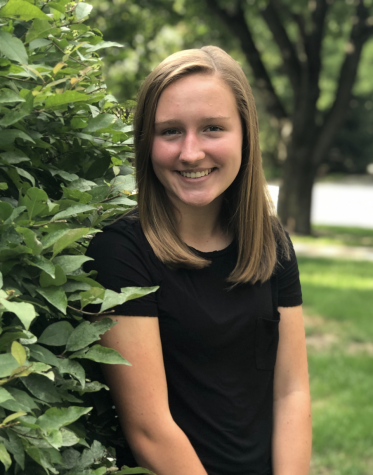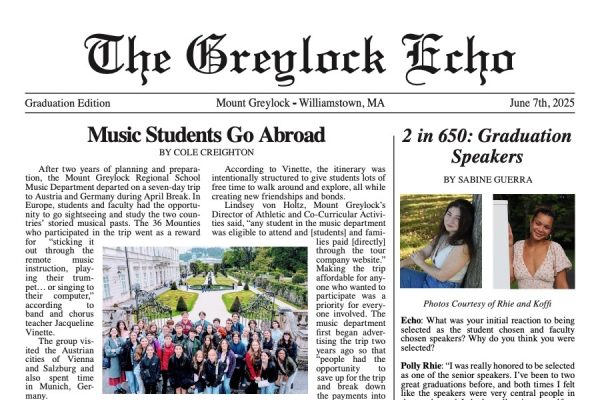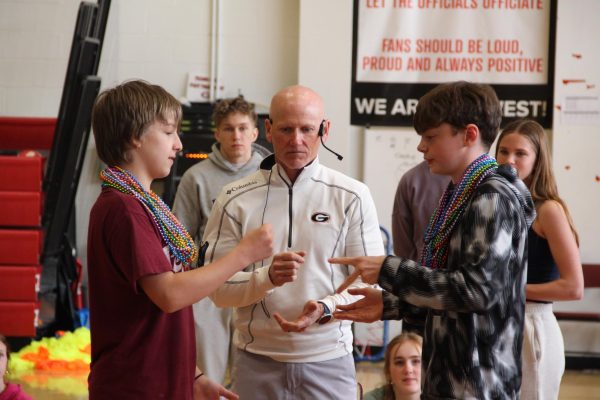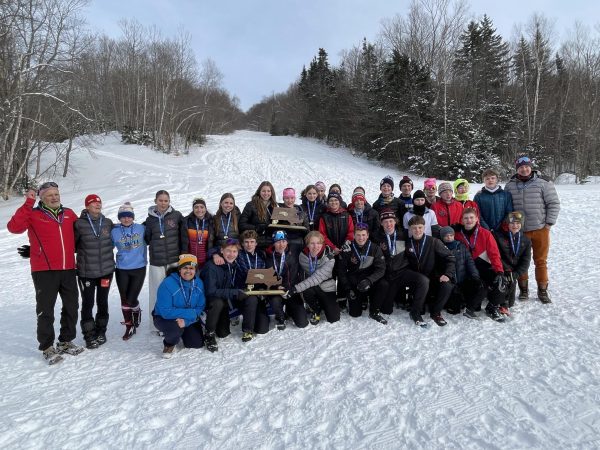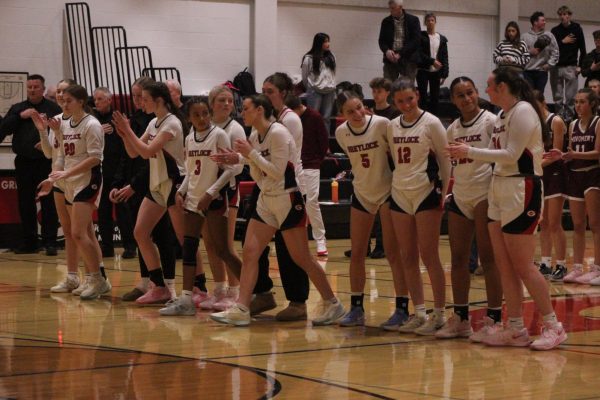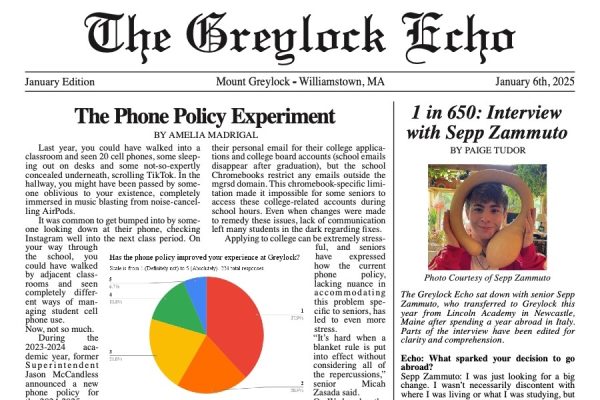Virtual Learning During COVID-19
On Monday, April 13th, Mount Greylock officially began its first full week of virtual learning after school had been closed for a month due to the unprecedented outbreak of COVID-19.
On April 8th, the School Committee voted that teachers would work through the spring break that would have occurred from April 13th to April 17th and virtual learning would continue during that time. The teacher’s union has agreed upon assigning 2.5 hours of work for each class and having 20 minutes of direct contact with students per week. It has also been decided that the rest of the school year will be graded on a pass-fail basis.
With the switch to online education, many classes have had to adjust. Science teacher Mrs. Starz will no longer be teaching her classes with a baby on the way, so Ms. Holmes will now be teaching her biology classes. While Mr. Bell was supposed to come in as a substitute for her two health classes, he will no longer be teaching them during this time. Instead, health will be suspended as a formal class for the rest of the semester and may be picked up by the rest of the wellness department in the future.
During this time, teachers are using a variety of platforms to connect with their students. Many teachers are having to navigate new technologies and push themselves out of their comfort zones, adjusting to this new way of life. The expectation is for teachers to use what they know to the best of their abilities. Principal Mary MacDonald said, “I’m not asking teachers to learn on the fly, but most teachers are familiar with Google Suites in some way. For example, people who have used Google Sheets or Google Forms are learning how to turn that into a quiz.” Other teachers, like Calculus teacher Robert Thistle, are reaching out to their colleagues to learn new skills to connect with students. Thistle said, “I am using Screencastify. [History teacher] Mr. Blackman taught me how to use it.”
One of the most important aspects of virtual learning is keeping communication with students effectively. Some teachers have chosen to use emails to send messages and video lessons, while others are sending out announcements via Google Classroom and Canvas. Teachers have been experimenting with Zoom conference calls as well to teach live, interactive lessons where students have the ability to ask questions in real time.
A lot of teachers, such as English teacher Jessica Cook, were already using some of these online programs to communicate with their students. Many students, especially in the language department, have taken advantage of websites typically used for enrichment in the classroom, like Duolingo and Khan Academy. Some have even gone out in search of their own resources, such as junior Ruth Weaver, who said, “Kaplan has a free 30 day SAT prep course that I like.”
On how effective and engaging these online programs have been so far, Physics teacher Shawn Burdick said, “More than half of my students, at all grade levels 9-12, are currently staying active and well-engaged!” Additionally, teachers are taking this time to encourage independent activities that weren’t necessarily emphasized while in school. Cook said, “I am also excited to continue encouraging and fostering independent reading when so often students ‘Don’t have time to read…’ Now we have an abundance of time!’”
Still, challenges for teachers have been numerous. MacDonald said, “It has been challenging to work on timing, as well as trying to find a pace and consistent communication. We are trying to be flexible and respect that students can’t be expected to sit in front of a computer for a school day.” A lot of teachers are learning new technologies during this time, while also trying to help their own kids. Cook said, “It’s definitely a new challenge to try and teach, zoom, connect, etc. with my own two small humans at home who require feeding, playing with, attention, reminders, etc.”
For others, it is tough to be limited in the material they can continue to teach. Burdick said, “I am frustrated with the state DESE’s and MG administration’s decisions NOT to move forward with the curriculum, NOT to grade work, and to keep things optional.” There is a lot of anxiety around the new modified AP tests, as well as MCAS. Burdick said, “It is the uncertainty that is the hardest.”
As far as assessments go, it really depends upon the teacher. Seeing as all classes will be done on a credit-no credit basis, traditional testing won’t occur. Some teachers, like Burdick, are sending home tests and trusting students to complete them honestly and send back photos of completed work. Others are anticipating that assessments won’t be a large part of their curriculum. Thistle said, “I haven’t assigned assessments, just math problems to work on to keep the mind sharp.”
A big question from many students is how much work will be assigned and when. Burdick said, “I am providing a set of assignments every week or so.” Other teachers like Mr. Thistle, who have students working on AP and SAT practice exams, are checking in two or three times a week with videos going over different problems that students struggled with. A general trend among high school teachers is to assign work on Monday for the entire week and let students divide their time based on their own schedule. Those assignments would then be due on Friday. Cook said, “I’m assigning work each week and allowing them to organize their time in the best way for their own lives. For instance, there are 5 assignments—one student might choose to do them all on Monday, another on Friday.”
Quite a few students have voiced concerns over the sudden amount of work after a month of getting all optional assignments. Junior Charlotte Sanford said, “I wasn’t getting a lot of assignments and then all of a sudden there were a ton.” Junior Kyle Trottier echoed her sentiments and said, “I feel teachers should work their way slowly into virtual learning. All this work so quick is going to cause kids to panic.”
However, others seem to be finding effective ways to budget their time. Freshman Jennah Simpson said, “I spend about a half an hour to an hour per class per assignment. Senior Cole Filson added that he has been generally pleased with the way teachers have handled virtual learning. Filson said, “I think that my teachers have planned a schedule that doesn’t stress us out so they have done well in that regard and because of that I really don’t have anything else I would ask them to do.”
Others still have suggestions about the technology used for virtual learning. Freshman Kiersten Simpson said, “Honestly, I wish there were more zoom calls. I really appreciate having face to face learning as much as possible. Or at least, hearing a teacher explain something to me.” Junior Hannah Gilooly said, “I wish teachers would understand that they are overwhelming us and that we are learning about platforms just as they are, so they should be more flexible.”
Mount Greylock is also working upon ensuring equity for all students. The school has made Chromebooks available to those who didn’t have one prior to COVID-19. Mobile hotspots will be provided for those who aren’t currently able to access virtual assignments online.
The attempt to adjust to schooling during COVID-19 has been a learning curve for other schools around the world as well. Ava Sandstrom, a freshman from Taylor Allderdice High School in Pennsylvania, said, “So far everything has been on my own. I’ve tried to keep up with all my core classes at least, emailing teachers and finding online courses and other resources to use.”
On the other hand, private schools seem to be acting with a more set-in-stone schedule. Maddie Ball, a sophomore at Headington School in Oxford said, “We have six periods in a day. For most lessons, there would be about a 10 minute Google Meet at the beginning of the ‘lesson’, and then we would have the rest of the hour to do the work that had been set.” Despite being out of the classroom, the students are expected to follow a similar schedule, with set times for lunch and independent study.
Ultimately, virtual learning is clearly a learning process for students and teachers alike. MacDonald said, “As a person, I’ve learned how important it is to recognize how differently people will respond to such an unprecedented situation, which has helped me make decisions.”

Emma Sandstrom has been a member of the Echo since her freshman year. She has studied journalism at the Medill School of Journalism summer program (2021) and also took part in the Harvard Crimson's Fall Series (2021). Emma is interested in incorporating more multimedia platforms to the Echo.
When she isn’t writing/editing stories, Emma can be found either on the volleyball court, on a mountain, or cheating at sudoku.


